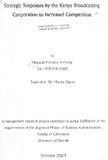| dc.contributor.author | Migunde, Florence A | |
| dc.date.accessioned | 2013-05-12T09:08:21Z | |
| dc.date.available | 2013-05-12T09:08:21Z | |
| dc.date.issued | 2003-10 | |
| dc.identifier.citation | Masters Of Business Administration (MBA) Degree, University of Nairobi | en |
| dc.identifier.uri | http://erepository.uonbi.ac.ke:8080/xmlui/handle/123456789/22343 | |
| dc.description | A management research project submitted in partial fulfillment of the
requirements of the degree of Master of Business Administration,
Facuity of Commerce
University of Nairobi | en |
| dc.description.abstract | The Broadcast Media Industry (BMI) operates in a highly dynamic environment, which is a
common characteristic in the modern liberalized business world. In such circumstances it is
imperative for business organizations to be ahead of developments in the industry to realize
success. This case study sought to identify the forces of increased competition in the BMI that
have affected the Kenya Broadcasting Corporation (KBC) and to determine the strategic
responses the Corporation has adopted to cope with such forces.
The study was based on Porter's Five Forces Model modified to include the aspect of
government influence. Given that KBC is a state-owned public broadcaster, the government
exercises some influence in determining the strategic direction of the Corporation. In
determining the strategic response, the study was generally guided by product-market strategic
alternatives.
Findings from the study indicate that competition in the BMI has intensified over the last decade
as shown by increased collective strength of industry competitive forces. The response strategies
have been minimal and reactive in nature thus creating some limitations to achievement of
sustainable competitive advantage. This resulted in dislodging of KBC from industry leadership
to a mere follower whose future success is threatened unless something is done fast to turn it
around.
The study recommends further research that seeks to unoerstand the extent of government
influence on public corporations faced with competition. Whereas the need for a clear strategic
direction was evident, KBC also requires a clear separation between commercial and public
broadcasting roles in order to compete effectively in the liberalized, competitive market. | en |
| dc.language.iso | en | en |
| dc.publisher | University of Nairobi | en |
| dc.title | Strategic responses by the Kenya Broadcasting Corporation to increased competition | en |
| dc.type | Thesis | en |
| local.publisher | School of Business | en |

